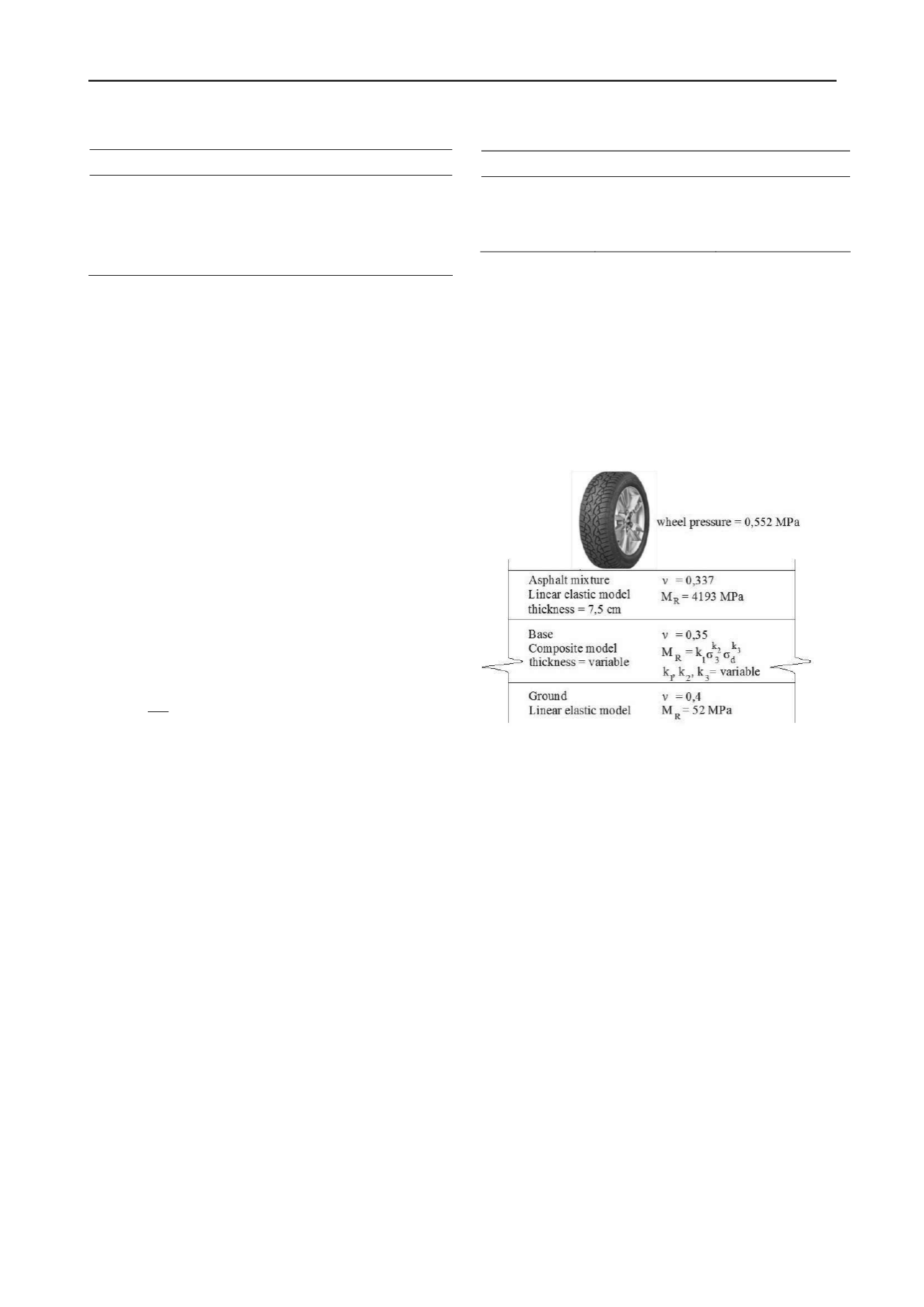
3264
Proceedings of the 18
th
International Conference on Soil Mechanics and Geotechnical Engineering, Paris 2013
3 23.
d
Table 1. Material’s symbols
Material
% Soil
% MSW fly ash
Symbol
Soil
100
0
S
MSW fly ash
0
100
CV
Mixture 1
60
40
S60/CV40
Mixture 2
80
20
S80/CV20
1
k k k RM
r
d
RM
3.2 Experimental tests
3.2.1 Chemical and physical characterization
Tests such as X-Ray Fluorescence, Organic Matter Content,
Lixiviation and Solubilization; Granulometric Analysis and
Atterberg’s Limit, MCT Test and Proctor Compaction Test
were conducted.
3.2.2 Resilient modulus test
The tests were performed according to standardized test in the
Geotechnical Laboratory of Federal University of Rio de
Janeiro, into molds of 10 x 20 cm compacted at optimum
moisture obtained in the compaction test.
In the cyclic load triaxial test, deviator stresses are applied in
the sample top, always in the compression direction, furthering
a load and unload, whereas the minor principal stress remains
constant.
Each sample was subjected to eighteen stresses states were
applied, with principal minor stress ranging from 0,021 to 0,137
MPa and deviator stress ranging from 0,021 to 0,412 MPa.
The Resilient Modulus (M
R
) of soil is the relationship
between the deviator stress (σ
d
) applied repeatedly in a sample
of soil in triaxial test and the corresponding specific recoverable
or resilient strain (ε
r
). As shown in Equation 1 (AASHTO
TP46-94 1996).
(1)
Where:
M
R
: resilient modulus;
σ
d
: cyclic deviator stress (σ
1
- σ
3
);
ε
r
: resilient strain (vertical).
The composite model used in this study relates the resilient
modulus of minor principal stress and deviator stress, as shown
in Equation 2.
(2)
Where:
σ
3
: minor principal stress;
σ
d
: cyclic deviator stress (σ
1
- σ
3
);
k
1
, k
2
and k
3
: correlation coefficients, derived from results of
laboratory tests.
This model was chosen because it presents bigger correlation
coefficients to the incorporating the minor principal stress and
the deviator stress influence. The nonlinear least squares model
estimation was utilized to obtain the correlation coefficients.
In order to evaluate the influence of cure time, optimal water
content samples were prepared and next rolled into hermetically
closed plastic bags for 7 and 21 days. Soon afterwards, these
were proceeded to the resilient modulus tests.
3.2.3 Permanent deformation test
The tests were performed according to Guimarães (2009), using
the same molds used in the Resilient Modulus Test. A total of
500,000 load cycles were applied for each specimen.
Three tests were conducted in the Mixture S60/CV40,
in the condition of maximum dry density, at stress levels shown
in Table 2.
Table 2. Permanent deformation tests
Test Number
σ
3
(MPa)
σ
d
(MPa)
1
0,098
0,294
2
0,118
0,353
3
0,098
0,392
3.2.4 Pavement design
A pavement structure was assumed (Figure 1) considering Rio
de Janeiro’s weather, with the purpose of exploring the effects
of adding MSW fly ash in soil on pavement project one. The
thickness and mechanical properties of the coated asphalt and
subgrade remain constant, so that only the the thickness of the
base may be modified, according to the parameters of resilience
for each material. As for the mechanistic-empirical analysis, the
computer program SisPav (Franco, 2007) was used. Bernucci
(1995) indicates for Brazilian low traffic roads an N value of
10
4
to 10
6
should be used. Thus, in this study, N value of 10
5
was assumed.
Figure 1. Pavement structure adopted.
4 RESULTS AND DISCUSSIONS
From the test conducted, the characteristics and effects of the
addition of MSW Fly Ash into soil were studied.
4.1 Chemical characterization
The main chemical components of soil, which are normally
found in residual soils, are SiO
2
, Al
2
O
3
and Fe
2
O
3
, such as
showed in the Table 3. Lixiviation and Solubility tests
performed according to Brazilian standards NBR 10005 and
NBR 10006 for MSW fly ash and soil stabilized with 40% fly
ash content. The mixture is classified non - dangerous and non-
inert (Vizcarra 2010).
4.2 Physical characterization
MSW fly ash and mixtures can be noted as follows: first, the
Atterberg Limits for pure MSW fly ash could not be performed
due to the behavior of granular material, which during the test
did not show plastic characteristics to their achievement.
Second, the inclusion of MSW fly ash decreases the liquid limit
and plasticity index, and increases the plastic limit of soil.
According the classification MCT (Nogami & Villibor
1995), the soil is classified as NG’ behavior "non-lateritic-clay."
When compacted under the conditions of optimum moisture
content and maximum dry unit weight for normal energy
compaction, these soils present characteristics of traditional
highly plastic and expansive clays.
The use of these soils is related to restrictions resulting from
its high expansibility, plasticity, compressibility and contraction


